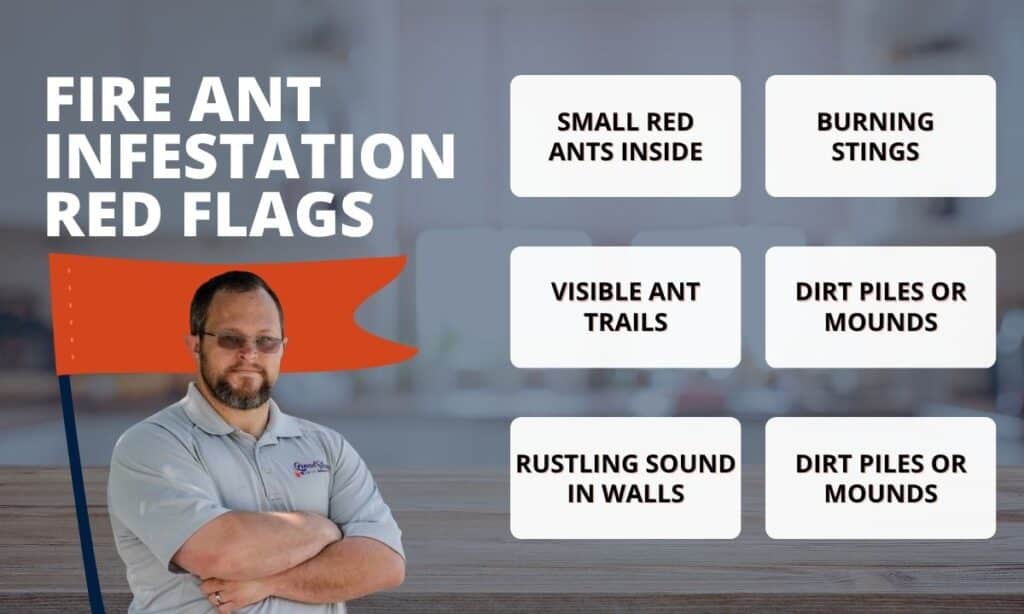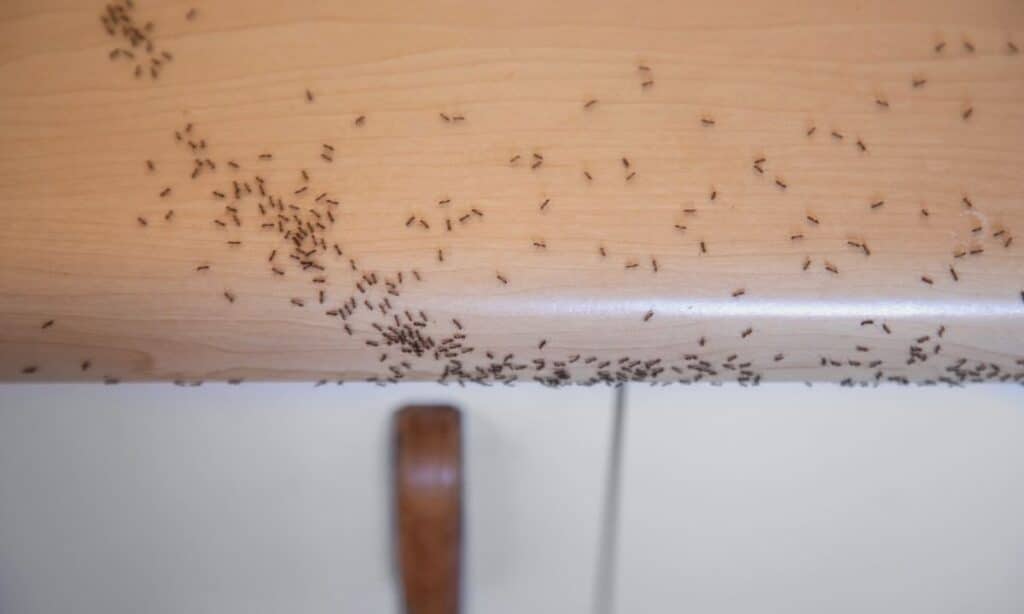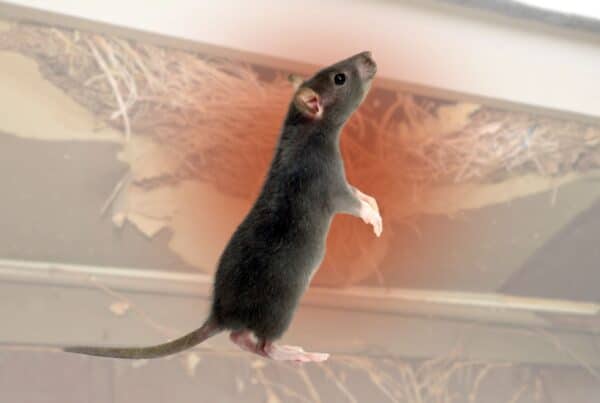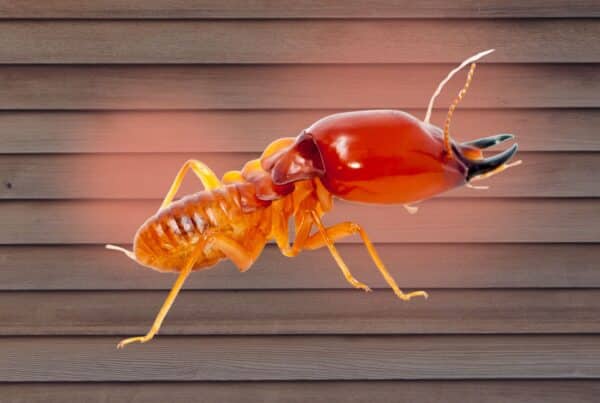Fire ants are more than just a painful nuisance. When an ant colony makes their way into your house and begin a full-blown infestation, they can sting, swarm, and damage wiring or insulation. An indoor fire ant infestation is never normal. If it’s happening to you, it needs to be dealt with fast.
Here’s how to spot the signs, what causes fire ants to come indoors, how to get rid of them safely, and most importantly, how to keep them out for good.
Why Fire Ants Invade Homes
Fire ants usually build their colonies outdoors in soil, mulch, or lawns. But when temperatures shift, food becomes scarce, or heavy rain floods their nests, they may start looking for shelter indoors.
They enter homes through:
- Cracks in the foundation
- Gaps around windows or doors
- Utility lines and HVAC access points
- Torn screens or gaps under siding
Once inside, fire ants are usually in search of warmth, food, or water. Kitchens, bathrooms, laundry rooms, and baseboards become ideal hiding spots. Colonies can quickly establish themselves inside walls, beneath flooring, or near moisture sources.

Signs of a Fire Ant Infestation Indoors
Spotting one or two in the house might not seem like a big deal, but with fire ants, that can quickly become a total ant infestation. These pests multiply fast and are known to build satellite colonies in hard-to-reach places.
Common warning signs:
- Small red or reddish-brown ants seen in high-traffic areas
- Ant trails near baseboards, vents, or outlets
- Bites or stings with a burning sensation and a small blister
- Dirt piles or nesting activity around windowsills or baseboards
- Buzzing, crackling, or rustling sounds inside walls (rare but possible in severe cases)
Unlike other ant species, fire ants are aggressive. If disturbed, they will defend their nest by stinging repeatedly.
How Dangerous Are Fire Ants Indoors?
While fire ants are not typically lethal, their stings are painful and can be dangerous for people with allergies or young children. In some cases, stings may trigger:
- Severe swelling
- Nausea or dizziness
- Difficulty breathing
- Anaphylaxis (in rare cases)
Even without allergic reactions, a swarm of ants inside your home can make daily life uncomfortable or even unsafe. Pets are also at risk, especially smaller dogs or curious cats.
Additionally, fire ants can chew through insulation, wiring, and HVAC components. That kind of damage adds up fast. Fire ants cause over $6 billion in economic damage in the U.S. each year, including medical treatments, property losses, and control efforts
How to Get Rid of Fire Ants in the House
Fire ants are not a DIY pest. Over-the-counter sprays may kill a few scouts, but they won’t reach the nest. In fact, disturbing a fire ant colony without proper treatment can cause the ants to spread and create new colonies in other parts of the home.
Professional fire ant control usually includes:
- Thorough inspection to identify access points and nesting sites
- Bait systems designed to be carried back to the colony and eliminate it at the source
- Targeted treatments around entry points and high-traffic zones
- Follow-up visits to ensure the infestation is fully cleared
If you spot fire ants indoors, avoid disturbing them directly. Instead, note where you see the activity and contact a licensed pest control provider as soon as possible.
Long-Term Prevention Tips
Once fire ants are out of the house, keeping them out is just as important. These prevention strategies can help protect your home long-term:
- Seal foundation cracks, gaps around windows, and utility openings
- Repair damaged screens, weather stripping, and door sweeps
- Keep food stored in sealed containers and wipe up spills right away
- Fix indoor and outdoor leaks that attract moisture
- Rake mulch and landscaping at least 6 to 12 inches away from the foundation
- Trim vegetation away from the structure to eliminate bridges for pests
- Schedule seasonal pest control treatments to stay ahead of infestations
A strong prevention plan goes beyond just the ants you can see. Fire ants are excellent at hiding, which is why routine service and barrier treatments are a smart move, especially in southern climates where they’re most active.

Other Questions About Fire Ants Indoors
Can fire ants damage my home’s structure?
Not directly like termites, but they can chew insulation and wiring, and may cause water or HVAC issues if they invade key systems.
Are indoor fire ants different from outdoor ones?
No. They are the same species, but when they come indoors, they behave more aggressively due to stress and limited space.
Will DIY ant traps fix the problem?
Unlikely. Most traps only kill visible ants. Fire ant colonies require a different approach, and improper treatment can make things worse.
Can one colony lead to more?
Yes. Fire ants may build multiple satellite colonies, especially if the main one is disturbed. That’s why professional treatment is essential.
When to Call a Professional
Fire ants should never be ignored, especially if they’re inside your home. Call a professional if:
- You see more than a few ants in the same area
- You’ve been stung indoors or near entry points
- Ants reappear after cleaning or spraying
- You find ants near electrical outlets or wall voids
- Pets or children are at risk of exposure
Grand Slam Pest Control offers fast, effective fire ant control designed to eliminate the problem at the source and prevent it from coming back.
Final Thoughts
If you’ve found fire ants in your house or suspect an ant infestation, don’t wait for the problem to grow. These aggressive pests can sting, spread, and cause damage that goes beyond the surface.
Eliminating the infestation and protecting your home takes more than a quick spray. It takes a focused plan, expert treatment, and ongoing prevention. With help from the Grand Slam team, you can stop fire ants in their tracks and keep your home safe, comfortable, and pest-free.



